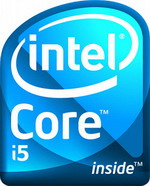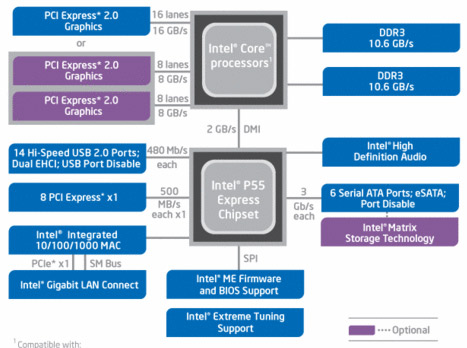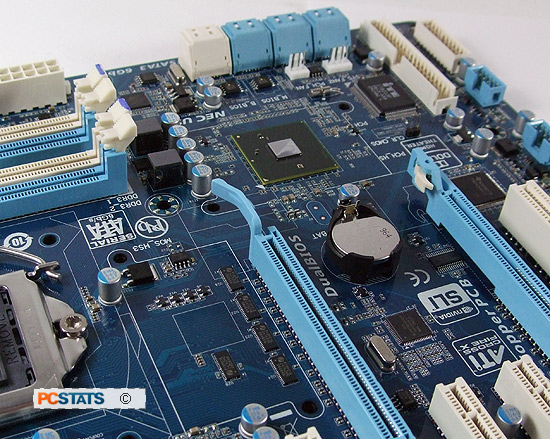Gigabyte Smart 6 Suite
Gigabyte is bundling a suite of small software
applications with motherboards based on Intel's P55 Express chipset. Called
'Smart 6' this suite work with Gigabyte's motherboards to
dynamical reduce power consumption, overclock the PC, create easy means of
backing up data, passwords and a few other tools. I think most users will
find only one or two features genuinely useful. PCSTATS has covered the Smart 6
software suite a few times in previous Gigabyte motherboard reviews, so if you
aren't familiar with it already please take a quick detour here for the full rundown.
Before we move on to the main benchmark section, let's get a little more familiar with Intel's P55 Express
chipset.
Intel P55 Express
Architecture
 Intel system architecture has traditionally
consisted of a three chip solution; the processor, a memory controller hub (MCH)
and I/O controller hub (ICH). This CPU-Northbridge-Southbridge
arrangement has until now happily survived many years of upgrading intact.
Intel system architecture has traditionally
consisted of a three chip solution; the processor, a memory controller hub (MCH)
and I/O controller hub (ICH). This CPU-Northbridge-Southbridge
arrangement has until now happily survived many years of upgrading intact.
As memory speeds increased, CPUs gained extra processing cores and videocards
grew more powerful, the interconnects that allowed all these components to
communicate increasingly became swamped with data. The solution Intel
implemented with the Core i7 platform first, and now with the Core i5 and Core
i3 processors was to move the memory controller from a discreet chipset directly
onto the CPU - a technique that AMD pioneered several years prior in
the Athlon 64 CPU. By moving the memory controller onto the
CPU itself, Intel simplified its platform to the two-chip
processor-southbridge architecture of today.
Intel's P55 Express chipset integrates both the memory
controller and sixteen PCI Express 2.0 lanes on to the die of the "Lynnfield"
CPU. The P55 Express Platform Controller Hub has eight further PCI Express lanes
at its disposal. This shift in the PCI Express graphics sub-system doesn't have
a huge impact on end-users, most P55-based motherboards still have two or three
PCI Express x6 videocard slots that can be run in (x16/x4) or (x8/x8/x4) mode,
the only change is that now the first two slots are handled directly by the CPU.

For gamers, both NVIDIA SLI and ATI CrossfireX multi-videocard technologies
are supported by Intel P55 Express chipset, though implementation varies with
each motherboard. Socket-1156 "Lynnfield"-compatible motherboards are
DDR3-exclusive, and support memory speeds from DDR3-800 up to DDR3-1333, with
overclocking going all the way up to DDR3-2000+ in some cases.

Since Intel's P55 Express doesn't have too many roles left to do (since
graphics and memory communication are now handled by the CPU), it actually
doesn't need a very fast link to the processor. Instead of equipping the Intel
P55 express chipset with a complex and expensive-to-produce QPI link, Intel has
instead selected a slower 2.0GB/s DMI link for the Intel P55 Platform Controller
Hub to communicate with the processor. Both northbridge and southbridge have
been merged into what Intel is now calling the P55 Platform Controller Hub.
Storage and media interface capabilities are pretty similar to that of
Intel's well-known ICH10R southbridge, which include support for fourteen USB
2.0 ports, six SATA 3Gb/s ports with support for RAID 0/1/5/10 and Gigabit
Ethernet.
Now for a look at the GA-P55A-UD4P
motherboards highlights in the photo gallery...!
